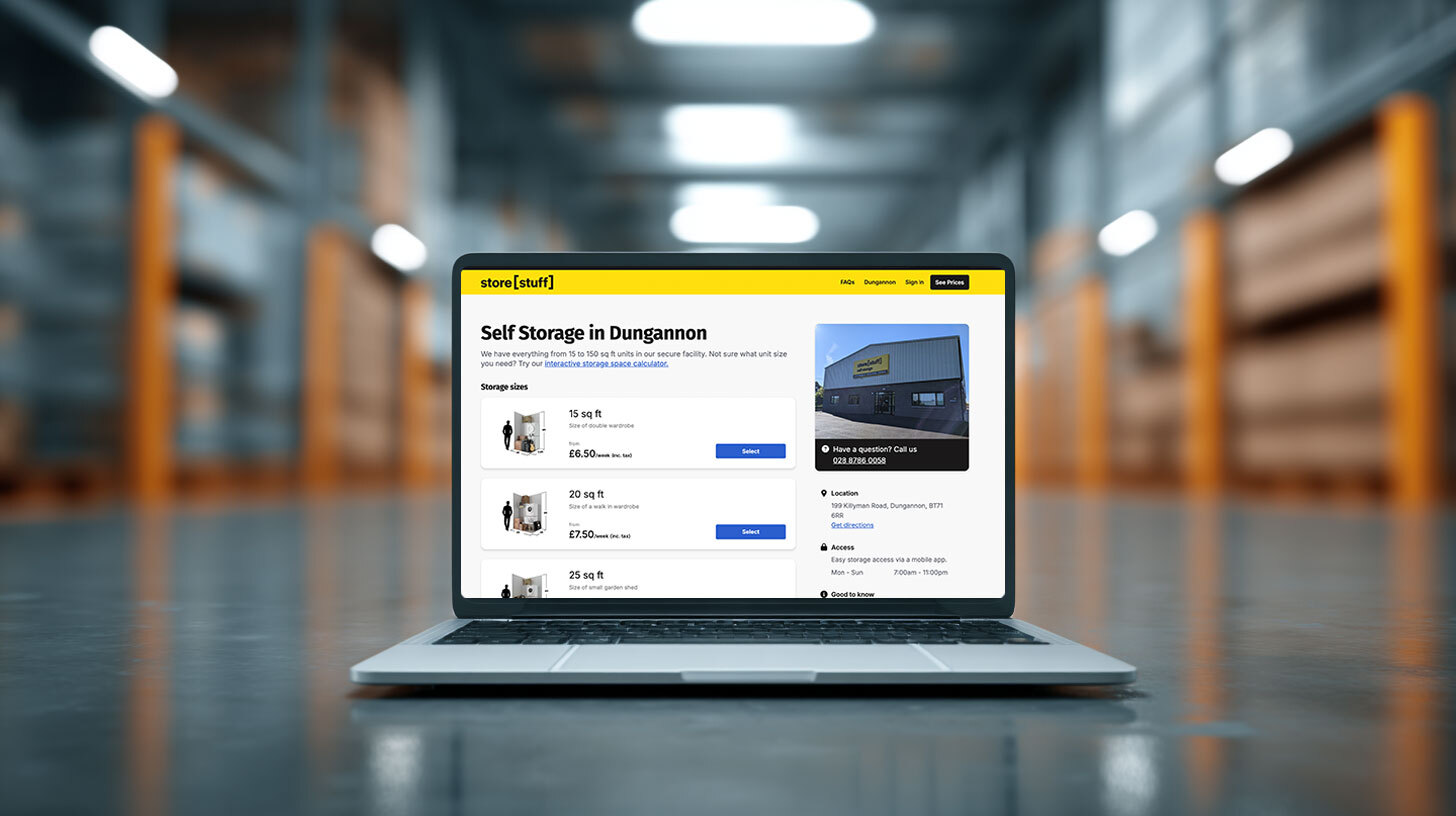Renting a climate-controlled self storage unit in the U.S. is, on average, $10 more expensive than a non-climate-controlled one. The average rent for a climate-controlled self storage unit is $149, while renting the smallest unit costs $53.
If you want to expand your profit margins and provide additional benefits to your customers, consider investing in climate-controlled units at your facility.
It costs around $35 to $70 per square foot to develop climate-controlled storage, including land, development, construction, permits, insurance, materials, and labor expenses.
While this may seem expensive, it’s well worth the investment when the average profit margin for climate-controlled storage is 11% per year.
If you’re not sure where to start when it comes to building climate-controlled units, we’re here to help. In this article, we’ll cover everything you need to know about implementing climate control at your self storage facility.
What Is Storage Unit Climate Control?
Source: Freepik
Storage unit climate control is a feature in self storage facilities designed to maintain consistent environmental conditions within units.
This involves regulating the temperature and, in some cases, humidity to protect stored items from extreme weather, temperature fluctuations, and moisture damage.
Climate-controlled storage units are particularly valuable for preserving sensitive or valuable items that can be damaged by extreme heat, cold, or humidity.
This feature is especially useful in regions with extreme weather, such as the hot and humid climates in Florida and Texas or the freezing climates found in Minnesota, Wisconsin, and New York.
Below are the three main features of climate-controlled units:
✅ Temperature regulation: These units generally keep temperatures within a range of 55°F to 85°F (13°C to 29°C), which helps to prevent extreme heat or freezing conditions.
✅ Humidity control: Some self storage facilities also offer humidity regulation to keep relative humidity below 50% to prevent mold, mildew, rust, or warping of the stored items.
✅ A sealed environment: Climate-controlled units are usually located indoors, providing better insulation and protection from dust, pests, and external weather conditions.
🤔 What Is the Difference Between Climate Control and Temperature Control? Temperature-controlled units regulate temperature only, ensuring it remains within a specific range to prevent high heat or freezing. On the other hand, climate-controlled units regulate both temperature and humidity, offering a more comprehensive solution for protecting sensitive items. |
Why Do Customers Need Climate Control?
Source: Freepik
Your customers need climate-controlled units to prevent damage to their belongings, which is why it’s important to meet this demand. Here are some of the reasons why potential customers may be attracted to a climate control offering:
❄️ It keeps items in good condition
Climate control ensures your tenant’s belongings remain in good condition, regardless of external weather conditions, as extreme temperatures can damage sensitive items over time.
For example, wood furniture can warp, crack, or split in fluctuating temperatures, while leather items can dry out and crack without proper temperature control.
❄️ It avoids issues like condensation
Condensation occurs when warm, humid air meets a cool surface, resulting in moisture buildup. In a non-climate-controlled unit, condensation can develop when temperatures fluctuate.
This condensation can lead to mold and mildew growth, affecting fabric, wood, or paper items.
Condensation can also cause unpleasant odors, stains, and even structural damage to items.
❄️ It allows for storing of specialized goods
Certain items require climate control due to their sensitivity to environmental changes. Self storage tenants may need climate control to store items such as:
🎹 Musical instruments: Instruments like pianos, violins, or guitars can expand, contract, or warp with changes in temperature and humidity.
🍷 Wine collections: Wine requires specific temperature and humidity conditions to prevent spoilage and ensure proper aging.
📦 Antiques: Items like vintage furniture, books, and heirlooms can deteriorate if exposed to fluctuating conditions.
Source: Freepik
❄️ Improving the customer experience
Climate-controlled units aren’t just about protecting belongings; they also improve the customer experience.
When visiting a storage facility, especially in extreme weather, a climate-controlled environment makes accessing and organizing items more comfortable for your tenants.
For example, in summer, the temperature inside non-climate-controlled units can be unbearable, and in winter, freezing conditions can make visiting units unpleasant.
⭐️ Pro Tip: Provide the Right Advice to Your Tenants Customers will often look to you for advice on how to best store both their special and everyday items. To meet their expectations:
|
Why You Should Provide Climate-Controlled Storage
Source: Freepik
There are several good reasons to provide climate-controlled storage to your tenants. Let’s look at these in more detail below:
➡️ You can charge more and potentially upsell
Offering climate-controlled storage units enables you to charge a premium compared to standard units.
On average, climate-controlled units cost 20% to 50% more than traditional storage units, but customers are willing to pay the added cost for the protection they offer.
Customers recognize the added value of protecting their belongings from extreme temperatures, humidity, and moisture damage, making them more willing to pay higher rates for this peace of mind.
Additionally, climate-controlled units create upselling opportunities. For example, tenants considering standard storage may be persuaded to upgrade when they understand the risks to their sensitive items in non-climate-controlled conditions.
➡️ Happier customers
Customers invest in storage to keep their belongings safe and secure. Climate-controlled storage ensures that their items remain in excellent condition, regardless of external weather conditions.
This increases customer satisfaction as they can rest assured their stored goods won’t be exposed to permanent damage caused by mold, warping, or rust.
Happy customers are more likely to leave positive reviews, recommend your services to others, and become repeat customers.
Source: Freepik
➡️ Pests are kept away
Climate-controlled units are typically housed with insulated indoor structures, which have several benefits beyond temperature regulation. One of the key advantages is pest prevention.
Thicker walls, sealed doors, and improved ventilation create an environment less hospitable to pests such as rodents, insects, or termites, which can damage stored goods.
➡️ Attract more tenants
Not all customers store basic household goods; many are looking for specialized storage options for valuable, temperature-sensitive items.
By offering climate-controlled storage, you can attract a broader customer base, including businesses and individuals with high-value or fragile items.
This can set you apart from competitors offering only standard units, making it an appealing option for a wider range of storage needs.
The Downside to Providing Climate-Controlled Storage
Source: Freepik
There are some disadvantages to providing climate controlled self storage units to your tenants:
❌ Greater costs: Installing and maintaining climate-controlled storage requires a significant upfront investment in HVAC systems, insulation, and humidity regulation equipment. Ongoing expenses include higher utility bills for heating, cooling, and electricity, as well as regular maintenance and repairs.
❌ Greater complexity: Climate-controlled units require more advanced systems to regulate temperature and humidity, which means more could go wrong. If these systems fail, customers’ items could be at risk, leading to complaints or liability issues.
❌ Smaller units: Climate-controlled units are often located indoors, where space is more limited than outdoor units. This setup generally results in smaller units, which may not appeal to tenants looking to store larger items like bulky furniture.
Types of Climate Control Storage Units
Source: Freepik
There are several different types of climate-controlled storage units available, each catering to different needs:
👉 Standard climate-controlled units: These units regulate temperature to stay within a specific range, typically between 55°F and 85°F (13°C to 29°C). They are suitable for items like electronics, wooden furniture, magnetic media, and clothing that can be affected by extreme temperatures.
👉 Humidity-controlled units: In addition to temperature regulation, these units maintain stable humidity levels, usually between 30% and 50%. This is crucial for items susceptible to moisture damage, such as documents, artwork, and antiques.
👉 Wine storage units: These are specialized units designed to store wine collections at optimal temperature and humidity levels, preserving their quality and flavor.
👉 Document storage units: Specialized units that offer climate control features tailored to preserve important documents and archives, protecting them from deterioration due to environmental factors.
👉 Indoor climate-controlled units: Located within a larger building, these units provide an added layer of protection against external weather conditions and are often more secure.
8 Factors to Consider When Building Climate-Controlled Storage
Source: Freepik
Now that you know more about climate controlled self storage, let’s look at some things you need to consider before building these units:
1. Location and climate
Your regional climate will significantly influence the demand and requirements for climate-controlled storage.
Facilities in regions like the southern U.S. and the South East of the UK will need robust systems to manage both high temperatures and humidity.
In colder regions, systems must protect against freezing conditions and maintain steady temperatures year-round.
Facilities in areas with significant seasonal changes may require advanced systems to handle wide temperature fluctuations effectively.
2. Building design and insulation
Your building’s structure plays a critical role in maintaining consistent climate control.
For example, high-quality insulation helps reduce energy costs by minimizing heat exchange and preventing air leaks, ensures stable indoor conditions, and reduces the risk of pests.
3. HVAC systems
The heating, ventilation, and air conditioning (HVAC) system is the heart of climate control. You’ll need to choose systems that can handle the size of your facility and operate efficiently to minimize operational costs.
You’ll want to ensure the system you choose regulates temperature and humidity levels. Installing backup generators to prevent interruptions during power outages is also a good idea.
4. Humidity management
In addition to temperature, controlling humidity is vital for protecting sensitive items. For this reason, you should install industrial-grade dehumidifiers to maintain humidity levels, typically below 50%.
You can also use sensors to monitor humidity levels in real-time and alert your staff if adjustments are needed.
5. Energy efficiency
As mentioned earlier, energy consumption can be a significant expense for climate-controlled units.
Choose systems with high energy-efficiency ratings and use LED lighting to reduce your electricity usage.
Invest in programmable thermostats and automated systems to optimize energy use during off-peak times.
Source: Freepik
6. Unit layout and size
As mentioned above, climate-controlled units are often smaller than standard outdoor ones due to indoor facility constraints.
You should prioritize maximizing the number of units while maintaining adequate ventilation and accessibility.
It’s also a good idea to offer a range of unit sizes to accommodate different customer needs, from small document storage to larger furniture units.
7. Pest control
Your climate-controlled facilities need to be designed to minimize pest infestations. You can do this by ensuring walls, floors, and ceilings are tightly sealed to prevent entry points for pests.
You should implement pest control measures and routine inspections to identify and address pest-related issues early.
8. Compliance with local regulations
It’s essential to check your local building codes and zoning laws to ensure your climate-controlled units comply with all relevant regulations.
Some areas have specific requirements for HVAC systems, fire safety, and environmental impact.
For example, the U.S. Department of Energy (DOE) mandates that central air conditioners installed in the North meet a minimum Seasonal Energy Efficiency Ratio (SEER) rating appropriate for the region's climate.
Source: Freepik
Invest in the Ultimate Self Storage Management Solution
Investing in climate-controlled self storage units is well worth it, considering you can charge more, upsell, and satisfy your customers.
Another investment that can significantly impact the profitability of your facility is self storage management software.
Stora is a powerful all-in-one self storage management solution that makes it easy to automate bookings, manage payments, and provide an exceptional customer experience—all from one intuitive platform.
Sign up for a free demo today and see how simple managing your self storage facility can be.







